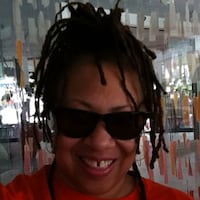Jerome Lawrence is a work in progress.
And that’s perfectly fine with him.
“I’m like a painting I’m working on,” said the soft-spoken Lawrence. “I don’t separate myself from my work. I don’t think you ever stop improving, learning and going forward.”
Lawrence, 53, an Atlanta-based artist and author, wants others to experience the evolution in his work and life. One of the people he’s impressed over the years with his talent, as well as his personal struggles, is former first lady Rosalynn Carter.
Several of his paintings are on display at Soda Salon in downtown Roswell. He works with a design firm that has placed others in hotels, offices and medical centers around the world. Several of his paintings hang in the Carter Center.
One of his works will be auctioned during the annual Carter Center Weekend this summer in Vail, Colo. Proceeds benefit the Carter Center’s peace and health programs in the United States and abroad.
“It’s like I was born into it (art),” Lawrence said. “I was born to be an artist. People think of art as a job or hobby, but I bought into the Michelangelo, (Leonardo) da Vinci renaissance kind of man. I thought of the artist as someone who discovers life and lives life to its fullest.”
Lawrence is known for his vividly colored acrylic paintings of flowers or subtle abstracts. He alternately uses a brush or his fingers to make broad, bold strokes. Or, he’ll take some of the paint and gently drop it on the canvas like cascading drops of rain.
Recently he started including creative writing with some of his paintings.
“It enhances the experience,” he said.
“iDo”
Hello! “Hello.”
Am I alone?
“Am I alone.”
Is anybody here?
“Here, here, here.”
“I am here!”
“I was just blown away by his work,” said Jay Beck, a consultant at the Carter Center and event coordinator for the Carter Center Weekend. “It’s wonderful how very gifted he really is.”
Lawrence has donated work to the annual auction before. Each time, Beck said, Rosalynn Carter gets up to say a few words about Lawrence.
In a way, he’s become a bit like “family. We have great affection for him here. Jerome is just a wonderful soul. He wanted to bring people to a more peaceful world. He’s such an ambassador, in a way, of our work. We’re all about peace in the world and trying to get people to understand each other and talk to each other.”
Lawrence’s relationship with Rosalynn Carter and the Carter Center goes back several years.
The two met in 2002 when she placed the cornerstone for Lawrence’s Atlanta house, which was built by Habitat for Humanity in partnership with the National Mental Health Association and the National Alliance for the Mentally Ill. The Carters have long been big supporters of Habitat, a nonprofit that repairs and builds affordable housing all over the world, and Rosalynn Carter is chairwoman of the Carter Center Mental Health Task Force.
The two talked and he showed her his portfolio. She was impressed. The friendship grew. Lawrence, who graduated from Columbia High School in 1978, was invited to hold a one-man show in 2004 at the center during one of its events.
But the relationship was built on more than art. More than three decades ago, while a senior studio art major at Georgia State University, Lawrence was diagnosed with paranoid schizophrenia, something he doesn’t hide from others. He had trouble concentrating in his class work and saw his grades slip from A’s to D’s then F’s.
“I wondered what was going on here,” said Lawrence, who does most of his painting today in the basement of Dennis Alexander, his friend and business consultant. “It turns out I was developing an illness. You don’t fall off the cliff. You solidly slip into the night. You gradually develop the illness.”
After a brief hospitalization, he eventually returned to earn a degree in studio arts.
He started painting portraits, then floral scenes against the advice of other artists. He said they thought paintings of flowers were too basic.
“People think if I make it more complicated, it will be worth more,” he said. “But that isn’t true. It doesn’t matter what it is, or whether it is a five-hour project or a five-minute project, people will buy what they like.
“You have to be fluid and open,” he said. “If you’re only focused on the end goal, you miss out on the beauty of the process.” To him, “the journey is the point of travel, not necessarily the destination.” He plans to continue to paint but also expand into digital design.
Art and music have been used in therapy to help people suffering from mental illness and trauma. But Lawrence’s connection to painting goes deeper, said Ruby Moore, executive director of the Georgia Advocacy Office, which works on behalf of people who are disabled or mentally ill, and a longtime friend. She calls Lawrence “a true, extraordinary talent. He reached deep inside himself and said this is central to who I am.”
Years ago, she remembers Lawrence was going through a dark period. “He came out on the other side of that place and had reinvented his art.” She owns several paintings, and several are in the advocacy office.
But she may have to hide a few.
Lawrence shared that his dream is to one day be wealthy enough to buy back some of his paintings.
“I like them all,” he said.
You get the sense there’s not a bit of ego in that comment.
“The only thing that consoles me is that they’re going into the homes of some good people.”
About the Author
Keep Reading
The Latest
Featured


